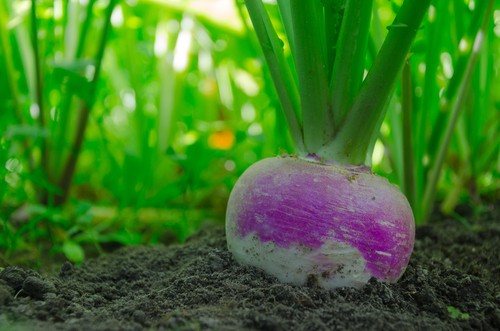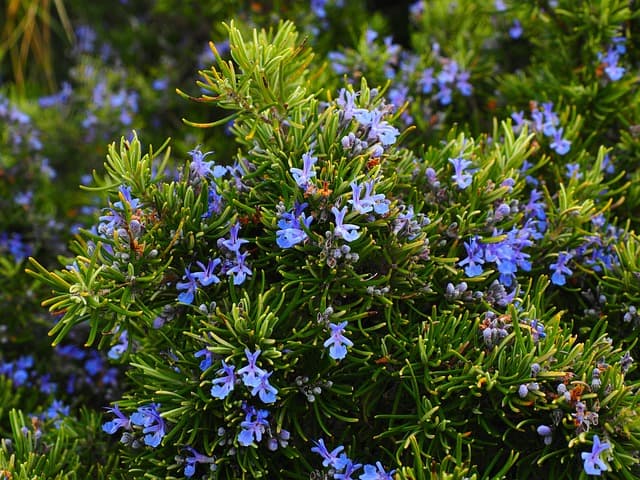Rhubarb is a wonderfully fragrant, vibrant, and delicious vegetable that is so easy to grow in a vegetable garden. Rhubarb also pairs well with a plethora of edible plants in a garden as their non-edible leaves help keep a lot of pests away, though rhubarb has its own pests to worry about.
The top 10 rhubarb companion plants are some more tasty, healthy foods that not only look nice when planted next to rhubarb, but these plants are mutually beneficial to each other.
Since lots of pests enjoy rhubarb as much as we do, companion planting in a strategic manner will help keep those at bay so all plants in your garden can flourish.
Above and beyond keeping pests away, your companion plants will be ones that typically require similar care and conditions to rhubarb, and help to share nutrients and water with each other. Here are the top 10 companion plants that pair well with rhubarb in a vegetable garden, providing mutual benefits to each other and helping to keep pests away.
Top 10 Rhubarb Companion Plants
You can end up with quite the tasty selection of produce when you make an effort to pick the proper companions for rhubarb. You’d also be surprised at how planting these crops together can help you grow some of the most fresh, flavourful produce you’ve ever eaten.
More similar posts:
1. Strawberries

Strawberries and rhubarb make the best companions in and out of the soil. Strawberries also grow low, so they can stop weeds from growing while keeping moisture within the soil. Both plants will share all the resources around, and are usually ripe for the picking at the same time.
Mature Size: Mature strawberry plants only grow between four and 12 inches tall.
Flowering: The ideal time to plant strawberries is in the middle of spring between April and May.
Key Features: Strawberries grow low to the ground, and plants feature green leaves with red berries growing from thin stems.
2. Kale

Kale and rhubarb both benefit each other as they both keep away pests that the other doesn’t like. As such, growing these two plants together makes sure that both your kale and rhubarb get to grow to completion.
Mature Size: Kale can grow one to two feet tall by the time it reaches maturity.
Flowering: Kale can be planted at the tail end of winter about a month or so before the final frost has melted.
Key Features: Kale grows in a floral pattern from a short and stout stem, featuring dark green leaves with wrinkles and waves throughout.
3. Cabbage

Like kale, cabbage deters common pests for rhubarb, making it a perfect plant to grow next to rhubarb. Furthermore, the leaves that grow on your rhubarb keep away the pests that are known to eat up cabbage and other brassicas.
Mature Size: Cabbage grows around 12 to 14 inches high and 18 to 24 inches wide.
Flowering: Cabbage needs to be planted indoors in a flowerbed in winter, then transported outside once the last frost is completely gone.
Key Features: Cabbage is a round plant with tight leaves that feature a wax-like film, and can be found in green, red, or purple.
4. Beans

Beans are fantastic around rhubarb because they stop aphids from eating up your rhubarb. Beans also help to add some very beneficial nitrogen into the soil which will benefit many of the plants in your garden. You’ll want to pick beans that don’t grow too high so they don’t steal too much sun from your rhubarb.
Mature Size: Beans usually grow to be about four to eight inches long and start to yellow when ripe.
Flowering: Plant beans in the spring after all frost has evaporated.
Key Features: Beans vary depending on type, but most grow on green stems surrounded by leaves, and grow within pods or shells.
5. Garlic

Garlic is another great pest deterrent for your rhubarb, as many pests like weevils don’t like the smell. Additionally, garlic can help keep some bigger animals out of your garden. You’ll just want to avoid planting garlic if you have beans planted close to your rhubarb, as they don’t get along.
Mature Size: Garlic plants, stem and all, reach 18 to 24 inches long at maturity.
Flowering: You can plant garlic between the fall and the spring.
Key Features: Garlic bulbs grow underground, and are attached to long stems with green blades at the top.
6. Turnip

Turnip is a vegetable with some bite, just like rhubarb. Turnips are able to keep a lot of nasty pests off of your rhubarb so it can grow to completion. As such, turnips make for excellent companions to many of the other companion plants on the list.
Mature Size: Turnips remain pretty small even when mature, typically measuring around 3 inches in diameter.
Flowering: Turnip can be planted any time after the frost is gone, between spring and fall.
Key Features: Turnip grows in the ground and has a series of green stems, with green leaves at the top.
7. Chives

Delicious chives smell fantastic to us, but they don’t smell so good to bugs, pests, slugs, and animals. This is of great benefit to your rhubarb plant. Similar to garlic, chives shouldn’t be grown near any bean or legume plants.
Mature Size: When chives are mature, they reach around 12 inches tall.
Flowering: The late spring is the best time to plant your chives.
Key Features: Chives have small white bottoms with a bulb, and long green stems that grow from the ground.
8. Marigolds

The stunning marigold flower compliments rhubarb well as they will help distract bad bugs from going after your rhubarb, as well as any other vegetables you have in your garden. As a bonus, they add some vivacity and color to your garden.
Mature Size: Mature marigolds range from six inches to three feet tall.
Flowering: Spring is the prime season to plant marigolds.
Key Features: Bright marigolds grow atop a bed of green leaves, and range in color and aroma.
9. Rosemary

Rosemary is a perfect companion choice for rhubarb, and is even a bonus to have around if you plant your rhubarb with plants from the brassica family; this includes cabbage, kale, broccoli, and cauliflower. Rosemary deters pests, such as the horrible cabbage beetle, helping other plants thrive.
Mature Size: Rosemary grows to heights of four to six feet tall at maturity.
Flowering: You can plant rosemary in spring or fall.
Key Features: Rosemary herbs grow upward in a shrub-like fashion, with thin green leaves and the occasional flower.
10. Dill

Dill not only keeps bad bugs off your rhubarb and other vegetables, but it helps attract good pollinators that will help your plants grow to their full potential. Additionally, dill and rhubarb compliment each other in the kitchen.
Mature Size: A dill plant can grow up to five feet tall when mature.
Flowering: Towards the end of spring or at the beginning of summer is when you should plant dill.
Key Features: The dill herb has green stems that grow out in branches towards the top, with very soft and wispy leaves.
The Benefits of Companion Planting for Rhubarb Health and Growth

Companion planting with rhubarb offers numerous advantages, including pest control, nutrient sharing, and improved growth. By selecting suitable companion plants, you can enhance the health and productivity of your rhubarb while creating a harmonious garden ecosystem.
Companion plants play a crucial role in deterring pests that target rhubarb, such as aphids and weevils. They act as natural repellents, reducing the risk of infestations and minimizing the need for chemical pesticides.
Additionally, these plants contribute to the overall biodiversity of the garden, attracting beneficial insects that aid in pollination and pest control.
Choosing Compatible Companion Plants for Rhubarb
To maximize the benefits of companion planting, it’s important to select compatible plants that thrive in similar growing conditions and have complementary characteristics. Here are a few additional companion plants that pair well with rhubarb:
Mint: Mint plants release a strong aroma that repels pests and adds a refreshing touch to your garden. However, it’s important to grow mint in containers to prevent it from spreading and becoming invasive.
Onions: Onions are excellent companions for rhubarb, as their pungent smell deters pests. They also help improve the soil by adding organic matter and preventing the growth of weeds.
Maintaining a Balanced Garden Ecosystem: Weed Control and Soil Health
In addition to pest control and nutrient sharing, companion plants contribute to weed suppression and soil health. Low-growing companions can act as ground covers, reducing weed growth and competition for resources.
It’s crucial to maintain weed-free soil around your rhubarb plants to ensure optimal growth. Regular weeding and mulching help prevent weed encroachment and retain moisture in the soil. Organic mulches, such as straw or wood chips, not only suppress weeds but also improve soil structure and fertility as they decompose.
To promote soil health and nutrient availability, consider incorporating organic matter, such as compost or well-rotted manure, into the soil before planting your rhubarb and companion plants. This enriches the soil with essential nutrients and enhances its ability to retain moisture.
Summary
Rhubarb not only enhances a lot of dishes, but as can be seen with the top 10 rhubarb companion plants, a lot of other vegetables and flowers in your garden benefit from it too.
These companions will also make sure your rhubarb is able to grow to be as fragrant and scrumptious as can be so you can make the perfect rhubarb pie with fresh ingredients.
Frequently Asked Questions
What Should Not Be Planted Near Rhubarb?
You should avoid planting sunflowers near rhubarb, as they tend to attract some of the most destructive pests to your rhubarb. Other plants that’ll compete with your rhubarb and stunt its growth include cucumbers, melons, dock, and black walnuts.
What Is The Best Location To Plant Rhubarb?
Rhubarb appreciates living in a spot that gets a solid amount of sun, and is fine with periodic bouts of shade. What’s going to be crucial is a spot with soil that drains water very well. When planning out your garden, be sure you don’t plant anything that is going to grow over your rhubarb and shield it from the sun.
How Much Space Do You Need Between Rhubarb Plants?
When you’re planning out your garden, make sure you can establish rhubarb roots at least three to four feet apart.
You want your plants to have enough room to breathe so they don’t sit in puddles of water or end up growing over each other. Low growing companion plants can help make sure no weeds grow around your rhubarb.

Hey, I’m Lisa and I’ve been an avid gardener for over 30 years. I love writing, talking and living in the garden! Feel free to connect with me on my socials below

